ТОП просматриваемых книг сайта:
Notes on the Floridian Peninsula; Its Literary History, Indian Tribes and Antiquities. Daniel G. Brinton
Читать онлайн.Название Notes on the Floridian Peninsula; Its Literary History, Indian Tribes and Antiquities
Год выпуска 0
isbn 4064066247706
Автор произведения Daniel G. Brinton
Жанр Документальная литература
Издательство Bookwire
Daniel G. Brinton
Notes on the Floridian Peninsula; Its Literary History, Indian Tribes and Antiquities
Published by Good Press, 2019
EAN 4064066247706
Table of Contents
§ 1.— The Early Explorations. 1512-1562.
§ 2.— The French Colonies. 1562-1567.
§ 3.— The First Spanish Supremacy. 1567-1763.
§ 4.— The English Supremacy. 1763-1780.
§ 5.— The Second Spanish Supremacy. 1780-1821.
§ 6.— The Supremacy of the United States. 1821-1858.
CHAPTER III. PENINSULAR TRIBES OF THE SIXTEENTH CENTURY.
§ 1.— Situation and Social Condition.
§ 1.— Yemassees and other Tribes.
CHAPTER V. THE SPANISH MISSIONS.
APPENDIX I. THE SILVER SPRING.
APPENDIX II. THE MUMMIES OF THE MISSISSIPPI VALLEY.
APPENDIX III. THE PRECIOUS METALS POSSESSED BY THE EARLY FLORIDIAN INDIANS.
PREFACE.
The present little work is the partial result of odd hours spent in the study of the history, especially the ancient history—if by this term I may be allowed to mean all that pertains to the aborigines and first settlers—of the peninsula of Florida. In some instances, personal observations during a visit thither, undertaken for the purposes of health in the winter of 1856–57, have furnished original matter, and served to explain, modify, or confirm the statements of previous writers.
Aware of the isolated interest ever attached to merely local history, I have endeavored, as far as possible, by pointing out various analogies, and connecting detached facts, to impress upon it a character of general value to the archæologist and historian. Should the attempt have been successful, and should the book aid as an incentive to the rapidly increasing attention devoted to subjects of this nature, I shall feel myself amply repaid for the hours of toil, which have also ever been hours of pleasure, spent in its preparation.
Thornbury, Penna., April, 1859.
THE FLORIDIAN PENINSULA.
CHAPTER I.
LITERARY HISTORY.
Introductory Remarks.—The Early Explorations.—The French Colonies.—The first Spanish Supremacy.—The English Supremacy.—The second Spanish Supremacy.—The Supremacy of the United States.—Maps and Charts.
In the study of special and local history, the inquirer finds his most laborious task is to learn how much his predecessors have achieved. It is principally to obviate this difficulty in so far as it relates to a very interesting, because first settled portion of our country, that I present the following treatise on the bibliographical history of East Florida. A few words are necessary to define its limits, and to explain the method chosen in collocating works.
In reference to the latter, the simple and natural plan of grouping into one section all works of whatever date, illustrating any one period, suggests itself as well adapted to the strongly marked history of Florida, however objectionable it might be in other cases. These periods are six in number, and consequently into six sections a bibliography naturally falls. The deeds of the early explorers, the settlement and subsequent destruction of the French, the two periods when Spain wielded the sovereign power, the intervening supremacy of England, and lastly, since it became attached to the United States, offer distinct fields of research, and are illustrated by different types of books. Such an arrangement differs not materially from a chronological adnumeration, and has many advantages of its own.
Greater difficulty has been experienced in fixing the proper limits of such an essay. East Florida itself has no defined boundaries. I have followed those laid down by the English in the Definitive Treaty of Peace of the 10th of February, 1763, when for the first time, East and West Florida were politically distinguished. The line of demarcation is here stated as “the Apalachicola or Chataouche river.” The Spaniards afterwards included all that region lying east of the Rio Perdido. I am aware that the bibliography of the Spanish settlement is incomplete, unless the many documents relating to Pensacola are included, but at present, this is not

